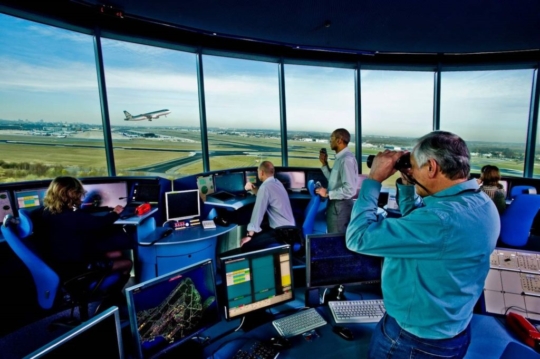Why Canada Needs an Industrial Aerospace Strategy
For over 80 years, Canadian engineering and manufacturing has been a cornerstone of the global aerospace supply chain and the envy of other countries around the world. This was thanks to the innovative and collaborative efforts of industry, a longstanding commitment from government and political determination to ensure Canada remained a leading aerospace nation.
“Canada maintains a distinct advantage as one of the only countries in the world capable of manufacturing an aircraft from nose to tail and certifying it.”
Today, Canada’s aerospace sector stands as a major engine of our economy, generating $27 billion in GDP, with over 80% of manufacturing revenues stemming from exports in 2022 (approximately $18.7 billion to 196 countries). In addition, Canada maintains a distinct advantage as one of the only countries in the world capable of manufacturing an aircraft from nose to tail and certifying it.
Investment in Aerospace

Photo credit TheFutureEconomy.ca
Despite our competitive advantages and world-class capabilities from coast to coast to coast, a lack of predictability and long-term planning for Canada has seen investment for aerospace research and development (R&D) diminish, resulting in Canada falling behind its competitors.
This begs the question, “What do other countries have that Canada does not, and what must Canada do now to not only compete but lead and win?”
For industry, the answer is clear: We need a strategy, much like our competitor nations, which recognize the value and potential of their aerospace sectors and are currently implementing strategies to enhance their industrial aerospace capabilities and capitalize on economic opportunities.
“Recent forecasts indicate a 28% increase in the global fleet over the next 10 years from 28,400 aircraft to 36,400 by the year 2034.”
What does that mean for Canada? As the global aerospace supply chain undergoes significant and transformative changes, propelled by disruptive, innovative, and world-class ideas that are shaping the trajectory of aerospace practises and technologies for decades to come, it is also poised for exponential growth. Recent forecasts indicate a 28% increase in the global fleet over the next 10 years from 28,400 aircraft to 36,400 by the year 2034.
This projected demand for new aircraft, coupled with aging fleets around the world that require maintenance, repair and overhaul services (MRO), presents a tremendous opportunity for Canada to leverage our distinct advantage and reclaim our position as a global aerospace powerhouse. Ensuring we are positioned to capitalize on this projected demand over the next decade will be critical, not only in terms of fortifying Canada’s leadership in the global aerospace value chain but providing economic stability for Canadians at a time when our country needs it most.
The Need for an Aerospace Strategy

Photo credit TheFutureEconomy.ca
Canada’s aerospace industry can be our ticket to greater economic stability, though we need a strategy to better align policies, investments and opportunities for civil aviation, defence and space so that they benefit Canada, ultimately creating more jobs, modernizing our defence capabilities and strengthening our industrial base.
“The global space economy reached $469B in 2021, but Canada failed to rank within the top five among countries in the spacetech sector.”
Take the global space industry. Canada’s contributions to satellite communications, Earth observation and robotics are substantial. However, according to the Space Foundation’s 2022 report, the global space economy reached $469B in 2021, but Canada failed to rank within the top five among countries in the spacetech sector. An industrial aerospace strategy would help Canada leverage our competitive advantage while aligning policies, investments and opportunities to unlock our potential for world-class ideas that lead to growth, innovation and technological advancements. This will help position our country as the leading aerospace nation of the 21st century.
“We will need more in R&D to enable the adoption of more sustainable aviation fuels (SAF), enhancement of aircraft efficiency and implementation of operational changes to reduce emissions.”
Canada’s aerospace industry is also committed to helping achieve our country’s environmental goals, including reaching net zero by 2050, as outlined in Canada’s Aviation Climate Action Plan. The targets laid out in Canada’s climate action plan are ambitious, and as industry continues working towards these objectives, we will need more in R&D to enable the adoption of more sustainable aviation fuels (SAF), enhancement of aircraft efficiency and implementation of operational changes to reduce emissions. We cannot take this journey alone. We need leadership from the government to ensure our collective goals are met and that Canada is not left behind by other countries.
Increased production and access to SAF, for example, will be critical. We need coordination throughout the supply chain, from feedstock suppliers to fuel producers, distributors and end users. Aligning various policies and investment opportunities through an industrial aerospace strategy for Canada would not only support our shared environmental goals but enable our country to play a leading role in the transition to more sustainable aerospace technology and practices. However, in the absence of a supportive regulatory environment and a clear commitment from the government to an industrial aerospace strategy for Canada, we are merely scratching the surface of our potential while allowing other countries to seize these opportunities in front of us and ensure the long-term viability of both their aerospace sector and national economy.
In addition to its economic and environmental contributions, Canada’s aerospace sector plays a vital role in international peace and security. Defence-related revenues accounted for 17% of Canada’s total aerospace revenue in 2020, highlighting the industry’s significance in safeguarding our borders and national interests. Released in April 2024, Canada’s latest Defence Policy Update (DPU) is a positive step forward, acknowledging the pivotal role of aerospace in protecting our interests and asserting our sovereignty. Yet, to institutionalize and operationalize the goals and objectives outlined in the DPU, an industrial aerospace strategy is essential. This strategy would not only complement the DPU but also provide the clarity and predictability needed to fortify Canada’s aerospace defence capabilities, drive innovation, attract investments and generate high-value employment opportunities for Canadians.
The Future of Canada’s Aerospace Industry
Considering the over 600 diverse aerospace companies spanning every corner of the country and the over 200,000 workers who rely on the industry to support their families, an industrial aerospace strategy for Canada is essential. It is our flight plan for growth and economic prosperity that will enable our world-class industry to enhance its competitiveness and solidify its position as a global leader in aerospace.
While uncertainty still looms as to the importance Canada places on its aerospace sector, the perception around Canada’s commitment to aerospace recently changed at the Aerospace Industries Association of Canada’s (AIAC) annual Aerospace on the Hill event. During the lobby event, Canada’s Minister of Innovation, Science and Industry, Francois-Philippe Champagne expressed his willingness to work with industry in crafting an industrial aerospace strategy for Canada. An aerospace strategy for Canada has also been endorsed by several key stakeholders over the years, including the House of Commons Standing Committee on Transport Infrastructure and Communities, the House of Commons Standing Committee on Industry and Technology and most recently, the House of Commons Standing Committee on Finance. This signifies a crucial turning point, with the stakes for Canada having never been higher.
As the voice of Canada’s aerospace industry, AIAC and our members stand united, ready to collaborate, innovate and do our part to pave the way for an industrial aerospace strategy for Canada that will propel our industry and the Canadian economy to new heights.
“We need action and a clear commitment from the government on an industrial aerospace strategy for Canada. Otherwise, we will continue to undermine our progress and global competitiveness.”
Building on the long-standing partnership between government and the aerospace industry in Canada, we have the capabilities, talent and expertise to take advantage of the opportunities on our radar. Now, we need action and a clear commitment from the government on an industrial aerospace strategy for Canada. Otherwise, we will continue to undermine our progress and global competitiveness while watching our place in the global aerospace ecosystem continue to erode.
Stay tuned for the upcoming State of Canada’s Aerospace Industry 2024 report, releasing in July.
This OpEd was originally published through TheFutureEconomy.ca .




